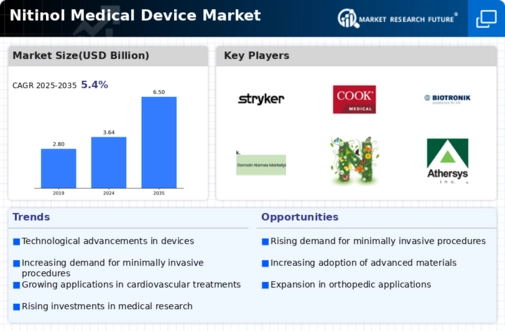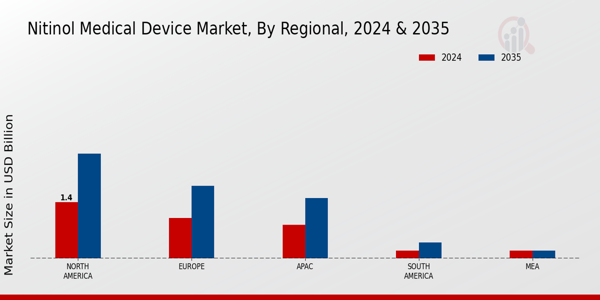Market Growth Projections
The Global Nitinol Medical Device Market Industry is projected to grow significantly, with estimates indicating a rise from 3.64 USD Billion in 2024 to 6.5 USD Billion by 2035. This growth reflects a compound annual growth rate of 5.41% from 2025 to 2035, driven by various factors including technological advancements, increasing demand for minimally invasive procedures, and a growing aging population. The market's expansion is indicative of the increasing reliance on Nitinol devices in diverse medical applications, highlighting their importance in modern healthcare.
Increasing Aging Population
The Global Nitinol Medical Device Market Industry is significantly influenced by the increasing aging population. As individuals age, they often experience a higher incidence of chronic diseases, necessitating advanced medical interventions. Nitinol devices, known for their biocompatibility and flexibility, are particularly advantageous for elderly patients requiring surgical procedures. This demographic shift is likely to drive demand for Nitinol-based solutions, thereby contributing to the market's growth trajectory over the coming years.
Regulatory Support and Approvals
Regulatory bodies are increasingly recognizing the benefits of Nitinol medical devices, leading to a more favorable environment for the Global Nitinol Medical Device Market Industry. Streamlined approval processes and guidelines for the use of Nitinol in medical applications are encouraging manufacturers to innovate and bring new products to market. This regulatory support not only enhances patient safety but also fosters competition among manufacturers, ultimately benefiting the market as a whole.
Growing Prevalence of Cardiovascular Diseases
The rising incidence of cardiovascular diseases globally is a critical driver for the Global Nitinol Medical Device Market Industry. Nitinol-based devices, such as stents and filters, play a vital role in the treatment of these conditions. With cardiovascular diseases being one of the leading causes of mortality worldwide, healthcare systems are increasingly investing in effective treatment options. This trend is expected to contribute to the market's expansion, as the demand for innovative Nitinol devices continues to rise in response to the growing health crisis.
Technological Advancements in Nitinol Devices
Innovations in the manufacturing processes and design of Nitinol medical devices are propelling the Global Nitinol Medical Device Market Industry forward. Enhanced fabrication techniques, such as laser cutting and advanced heat treatment, allow for the production of more complex and reliable devices. These advancements not only improve device performance but also expand their applications in various medical fields, including cardiology and orthopedics. As a result, the market is anticipated to witness significant growth, driven by the increasing adoption of these technologically advanced solutions.
Rising Demand for Minimally Invasive Procedures
The Global Nitinol Medical Device Market Industry is experiencing a surge in demand for minimally invasive surgical techniques. These procedures are preferred due to their reduced recovery times and lower risk of complications. Nitinol, with its unique shape memory and superelastic properties, is particularly suited for applications such as stents and guidewires. As healthcare providers increasingly adopt these advanced techniques, the market is projected to grow from 3.64 USD Billion in 2024 to an estimated 6.5 USD Billion by 2035, reflecting a compound annual growth rate of 5.41% from 2025 to 2035.



















